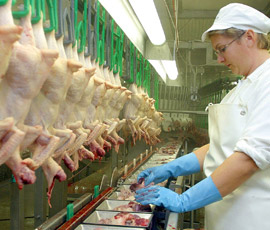FSA give high prority to campylobacter in chicken

Poultry producers have been told to step up their efforts to control campylobacter as part of a revised strategy from the Food Standards Agency.
The report, from FSA director of food safety Steve Wearne, is aimed at reducing the number of people getting ill from the bug – something the agency describes as its “top priority”.
“Campylobacter remains the most common cause of food poisoning in the UK, killing around 100 people every year,” it says. “Despite significant effort and investment, no progress has yet been made in reducing levels of campylobacter in chicken.”
A 2008 survey showed that 65% of chicken on sale in shops was contaminated with the bacteria. The FSA estimates that the disease costs the UK economy around £900m a year.
As part of the strategy, the FSA says it will improve the information about campylobacter at all stages of the supply chain, to ensure more effective risk management.
It will also address regulatory barriers to technological innovations that could help reduce contamination levels, and support research programmes into vaccination and other possible interventions.
In return, the FSA expects that:
- Farmers should undertake comprehensive monitoring of flocks and improve the effectiveness of biosecurity measures
- There should also be a focus on avoiding thinning
- Processors should improve hygienic practices to prevent contamination of carcasses in slaughterhouses
- They should also reward producers for low levels of contamination
- Retailers should develop packaging that reduces campylobacter load during storage and cross-contamination in kitchens
“What we have proposed is a shift in culture and a refocusing of effort by both government and the food industry to tackle this persistent and serious problem,” said FSA chief executive Catherine Brown.
“We want to encourage and see producers, processors and retailers treat campylobacter reduction not simply as a technical issue, but as a core business priority.
“I feel that because this is a complex and difficult issue there has tended to be an acceptance that a high level of contamination will inevitably occur and that there’s little that can be done to prevent it. The FSA doesn’t believe this is the case.”
The strategy was presented to industry leaders on 2 September. British Poultry Council chief executive Andrew Large said the poultry industry fully recognised its responsibilities.
“Since 2009, over 70 projects and scientific research in several areas have been conducted and new trials are taking place now. Overall, our knowledge of campylobacter has greatly increased and there are promising signs that certain actions across the poultry supply chain will contribute to meaningful reductions.
“In the coming months, we will review and improve biosecurity standards within the Red Tractor Farm Assurance Poultry Scheme as well as utilising new rapid-testing techniques for data collection.”
